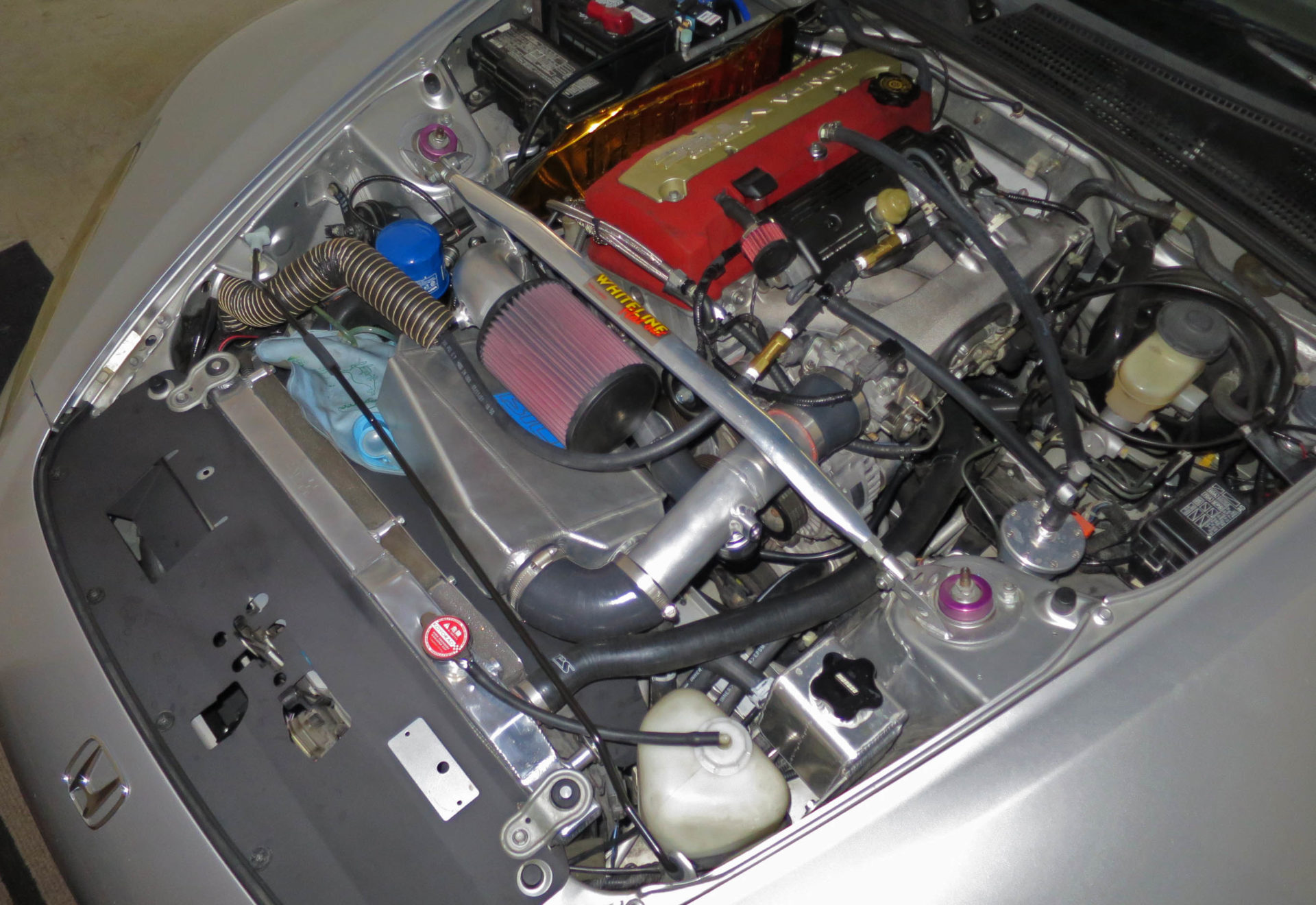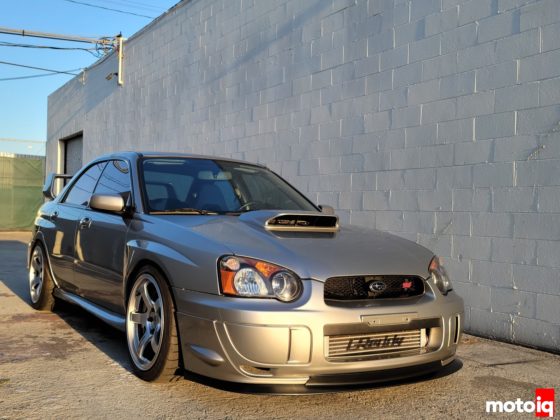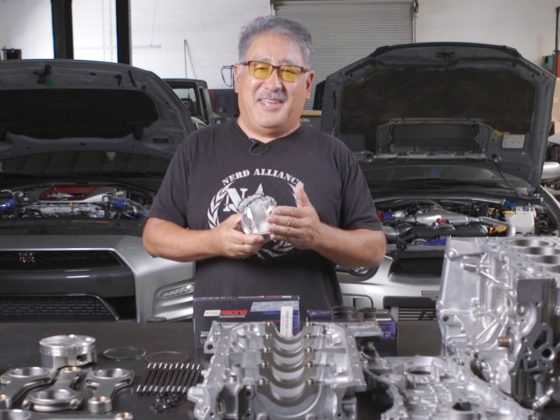 Eimer Engineering really squeezed in the Ford heat exchanger between the front bumper in cylindrical thing you see there which I think is the receiver/dryer for the A/C system. Random observation, my A/C condenser is beat up and it’s definitely restricting some airflow to the radiator.
Eimer Engineering really squeezed in the Ford heat exchanger between the front bumper in cylindrical thing you see there which I think is the receiver/dryer for the A/C system. Random observation, my A/C condenser is beat up and it’s definitely restricting some airflow to the radiator.
 I had bought two SPAL fans to put on the heat exchanger, but I decided to only use one. It’s only needed for when the car is stationary. The SPAL fan came with a cheap connector, so I replaced it with a Dorman connector bought at the local auto parts store that has proper water and dust sealing features. It turns out this is the exact same connector used on the Davies Craig EBP 40 coolant pump.
I had bought two SPAL fans to put on the heat exchanger, but I decided to only use one. It’s only needed for when the car is stationary. The SPAL fan came with a cheap connector, so I replaced it with a Dorman connector bought at the local auto parts store that has proper water and dust sealing features. It turns out this is the exact same connector used on the Davies Craig EBP 40 coolant pump.
 I wanted to see how much current the fan pulled, so I used a 12V battery jump pack to power the fan. The SPAL fan had a current in-rush of about 5A and settled in at about 3.5A.
I wanted to see how much current the fan pulled, so I used a 12V battery jump pack to power the fan. The SPAL fan had a current in-rush of about 5A and settled in at about 3.5A.
 The Davies Craig EBP40 brushless DC pump had more interesting behavior. Many brushless DC motors have power and signal connections in order to allow speed control. There’s always going to be some motor controller on a DC motor. This EBP40 pump only has power connections, so I’m assuming it has a small built-in motor controller. When you first connect power, it runs very quietly. Then after roughly half a minute, it gets relatively loud. At first, I thought I maybe had air in the system and it was causing the pump to cavitate. But then I measure the current the motor was using. The initial current in-rush when you turn on the pump jumps to 5A and then the pump settles into pulling about 0.5A. This is when the pump runs nice and quiet. Then when the pump gets loud, the current draw jumps up to ~2.4A. So my theory is the pump has a soft start for two reasons: not blow fuses from having too high a current in-rush and also not to cavitate from spinning up too quickly from zero flow. Then the pump cranks up in speed after the predetermined set of time. The pump is rated to have a maximum current draw of 4.3A, so that indicates to me the pressure drop of the system is not too high and also that the pump is well within its operating range.
The Davies Craig EBP40 brushless DC pump had more interesting behavior. Many brushless DC motors have power and signal connections in order to allow speed control. There’s always going to be some motor controller on a DC motor. This EBP40 pump only has power connections, so I’m assuming it has a small built-in motor controller. When you first connect power, it runs very quietly. Then after roughly half a minute, it gets relatively loud. At first, I thought I maybe had air in the system and it was causing the pump to cavitate. But then I measure the current the motor was using. The initial current in-rush when you turn on the pump jumps to 5A and then the pump settles into pulling about 0.5A. This is when the pump runs nice and quiet. Then when the pump gets loud, the current draw jumps up to ~2.4A. So my theory is the pump has a soft start for two reasons: not blow fuses from having too high a current in-rush and also not to cavitate from spinning up too quickly from zero flow. Then the pump cranks up in speed after the predetermined set of time. The pump is rated to have a maximum current draw of 4.3A, so that indicates to me the pressure drop of the system is not too high and also that the pump is well within its operating range.
 The values in the picture are after pulling off the highway and driving on surface streets with the A/C running. I have Motul 5w-30 oil in there and the oil pressure is solid at ~1.7 bar with an oil temp of ~92degC and idle speed of ~950rpm. If you recall, I bumped up the idle speed to 950rpm to avoid a lot of car shaking from the Hasport engine mounts. The good oil pressure indicates a low-pressure drop from the Improved Racing components and the Dyme PSI -10AN hoses and fittings. At highway speed and turning 3500rpm, the oil pressure was right at 6.0 bar with the oil temp between 90-94degC. Without A/C on, the oil temp is around 90degC and this was with air temps around 85degF or so. I think it’s running a couple degrees warmer than stock, but I also have a big heat exchanger for the intercooler system restricting the overall airflow to the radiator. An interesting thing about the new Koyo radiator is that the coolant stays at 86degC until I’m sitting in traffic. With the older Koyo, the coolant would sit at 90degC. I would think it would be all the same because the thermostat didn’t change, but maybe the new and thinner Koyo has less pressure drop which allows a higher coolant flow rate through the engine? For sure though, the coolant temperature increases significantly faster when sitting idle compared to the old Koyo because the new one is so much smaller volume which decreased the mass of coolant in the system. As soon as the radiator fans kick on, the temps drop right away.
The values in the picture are after pulling off the highway and driving on surface streets with the A/C running. I have Motul 5w-30 oil in there and the oil pressure is solid at ~1.7 bar with an oil temp of ~92degC and idle speed of ~950rpm. If you recall, I bumped up the idle speed to 950rpm to avoid a lot of car shaking from the Hasport engine mounts. The good oil pressure indicates a low-pressure drop from the Improved Racing components and the Dyme PSI -10AN hoses and fittings. At highway speed and turning 3500rpm, the oil pressure was right at 6.0 bar with the oil temp between 90-94degC. Without A/C on, the oil temp is around 90degC and this was with air temps around 85degF or so. I think it’s running a couple degrees warmer than stock, but I also have a big heat exchanger for the intercooler system restricting the overall airflow to the radiator. An interesting thing about the new Koyo radiator is that the coolant stays at 86degC until I’m sitting in traffic. With the older Koyo, the coolant would sit at 90degC. I would think it would be all the same because the thermostat didn’t change, but maybe the new and thinner Koyo has less pressure drop which allows a higher coolant flow rate through the engine? For sure though, the coolant temperature increases significantly faster when sitting idle compared to the old Koyo because the new one is so much smaller volume which decreased the mass of coolant in the system. As soon as the radiator fans kick on, the temps drop right away.
I have been driving the car a couple of months while doing all these little mods bit by bit. The car is really as quiet as it was before the turbo install. The main noise is still from the Hasport engine mounts. The intake has this ever so slight hum to it at idle and that noise disappears when moving. The loudest thing will be the Spal fan and the water pump. I was even looking at ways to reduce the voltage to the pump to slow it down to make it quieter. But maybe that’ll be a project for after I get everything running. The original plan for the Spal was to run it 100% of the time, but it’s so loud that I’m just going to wire it so that it comes on at the same time as the radiator fan whenever the coolant gets hot or when I turn on the A/C. The little 5” Spal fan is as loud as the radiator fans and I’d be really annoyed with that on all the time. I still need to do the wiring for the Spal fan and the EBP40 coolant pump, the AEM wideband, Science of Speed fuel pump wiring kit, install the fuel pump, new colder spark plugs, and the injectors will go in when it’s at Church Automotive for tuning. Oh yeah, I need to wire in the Hondata 4-port boost solenoid. I need to find time to do all this because it sucks not being able to go past a quarter throttle to stay out of boost. It’s fun to hear the turbo spinning up but it’s a big tease.
I can’t wait for the tune!




14 comments
Hey, if it’s not too late or too much of a pain in the ass to remove the oil lines with the heat sleeve on them, you may want to pull them off and get some of the adhesive lined heat shrink to put over the end of the sleeve. Keeps the fiberglass insulation from fraying/getting wet. Awesome build so far, cant wait to see it running!
I have super limited wrench time right now, so it has to go 100% to getting this car done. Good advice though!
Such a cool and detailed project. The packaging does not look fun at all. One has to wonder if a centrifugal supercharger would make more sense? e.g. something procharger or rotrex based. good high RPM power, less heat issues in engine bay, maybe better overall packaging?
Have you read the first 32 parts before commenting on this article, part 33?
A supercharger setup won’t do 320 torque crank at 3250rpm 🙂 I think my setup will do it on 91 octane. That’s the target at least! Double what a stock S2k will do and hold that torque flat to redline for 500hp crank at 8200rpm. I want double the mid-range torque to make the car more fun and useable on the street.
I am just so glad to see you get this far! Kudos! Can’t wait for a dyno pull, though!
Man….. FMIC for the win buddy, I’d tear all that out and start again
Have you read the first 32 parts before commenting on this article, part 33?
If it were a track car, air to air all the way. I’m targeting max response for the street, so minimizing the IC plumbing length along with keeping the intake air temps cool even from a stop. Sitting at a stop, I can have the SPAL fan going (A/C turned on) to keep the coolant cool and basically keep the IATs at ambient even leaving from a stop. Even without the SPAL fan running, there is a lot more thermal mass with the coolant in the IC system to reduce heat soak.
My goodness that’s a lot of careful packaging. Look forwards to when you can see what it’s all capable of!
Can’t quite tell from the picture of your I/C water pump but it doesn’t look rubber mounted, if you had some way to isolate it from the chassis the noise might be significantly reduced.
There’s a better picture in the link below. It’s a rubber mount/sleeve the pump slides into. Once the engine is running, you cannot hear the pump from inside the car. Outside the car, you really have to listen for it and stand near the corner where the pump is mounted to notice it. So no more worries on pump noise! I was over-thinking things a bit there.
https://motoiq.com/project-s2000-part-30-cooling-upgrades-and-packaging-improvements/5/
I had a W2A intercooler whose core loved back by the firewall. Silly me never ran a reservoir and that thing got HOT but wasn’t prone to puking. Yours is a much better setup, and I probably read it 20 episodes ago, but do you have a hood vent or something to keep the engine heat from dumping into the core? Being in front of the heat source helps I’m sure
No more vented track hood in order to stay low key. I have the air deflector underneath the intercooler core to shield it from the warm air from the radiator. The coolant pump runs 100% of the time for the IC so it’ll cool the core anytime I’m not boosting. At the situation of sitting at a stop light, I can turn on the A/C to run the fans including the fan on the heat exchanger for the IC system. I’ve tested it where if I turn on the A/C and run the heater at full blast, it’ll pull the engine coolant temp down pretty quickly. Even below the thermostat setting for a bit before the thermostat adjusts. Though in everyday driving, that won’t be necessary as I’ll be traction limited in first gear anyway.